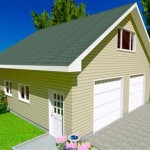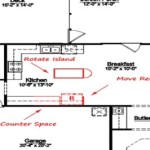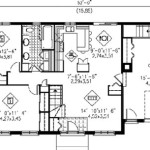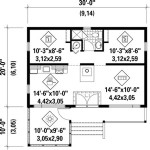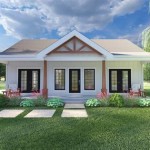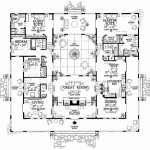Tiny Home Plans With Basements: Expanding Living Space Underground
The tiny home movement emphasizes simplified living and reduced environmental impact, often through minimizing square footage. However, the inherently compact nature of tiny homes can present challenges regarding storage, living space, and specialized areas like workspaces or hobby rooms. One potential solution is incorporating a basement, effectively doubling the usable area without significantly altering the above-ground footprint. Tiny home plans with basements offer a unique compromise, retaining the core principles of the movement while addressing practical limitations.
Basements in tiny homes provide additional functionality beyond simple storage. They can serve as bedrooms, offices, workshops, home theaters, or even in-law suites. The design and implementation of a basement in a tiny home plan requires careful consideration of several factors including local building codes, soil conditions, foundation type, and moisture management. Constructing a basement isn't always feasible or cost-effective, and the added complexity can offset some of the initial cost savings associated with tiny home living. Despite these potential drawbacks, the benefits of added space and functionality often outweigh the increased investment, making it a viable option for many homeowners considering a tiny home lifestyle.
Furthermore, the inclusion of a basement can increase the resale value of a tiny home. While the tiny home market is still evolving, potential buyers often appreciate the additional versatility a basement provides. A well-designed and finished basement can transform a cramped living space into a comfortable and functional dwelling, attracting a wider range of potential buyers in the future.
Key Considerations Before Building a Tiny Home with a Basement
Before committing to a tiny home plan with a basement, a thorough assessment of site conditions is critical. Soil composition plays a significant role in determining the suitability of a basement foundation. Soils with high clay content can expand and contract with moisture fluctuations, potentially causing structural damage to the foundation walls. Sandy soils, while generally stable, may lack the cohesiveness needed to support the weight of the structure, especially during excavation. A geotechnical survey is recommended to analyze the soil's properties and provide recommendations for the appropriate foundation design and drainage system.
The water table level is another crucial factor to consider. A high water table can lead to hydrostatic pressure against the basement walls, causing water infiltration and potential structural issues. Effective waterproofing and drainage systems are essential in areas with high water tables. This may involve installing a perimeter drain, waterproofing membranes, and a sump pump to remove any water that accumulates around the foundation.
Local building codes and regulations also influence the feasibility of constructing a basement. Many jurisdictions have specific requirements for basement construction, including minimum ceiling heights, egress windows, and insulation levels. It is essential to consult with local building officials to ensure that the basement design complies with all applicable codes and regulations. Failure to do so can result in costly delays and modifications during the construction process.
Finally, the overall cost of construction should be carefully considered. Adding a basement significantly increases the construction cost of a tiny home. Excavation, foundation construction, waterproofing, drainage, and finishing all contribute to the overall expense. A detailed cost estimate should be prepared to determine whether a basement is a financially viable option.
Design and Planning for Tiny Home Basements
Effective design and planning are essential for maximizing the functionality and livability of a tiny home basement. The basement's design should be integrated with the overall design of the tiny home, ensuring a cohesive and functional living space. Careful consideration should be given to the layout of the basement, the placement of windows and doors, and the integration of utilities such as plumbing and electrical systems.
Egress is a critical safety consideration in basement design. Building codes typically require basements to have at least one egress window or door that allows occupants to escape in case of a fire or other emergency. The egress window or door must meet specific size requirements and be easily accessible. Egress windows should be located in a window well to provide adequate light and ventilation.
Natural light and ventilation are essential for creating a comfortable and livable basement environment. Windows can be strategically placed to maximize natural light and provide cross-ventilation. Window wells can be used to enhance the amount of light that enters the basement. In cases where natural light is limited, artificial lighting can be used to supplement the natural light. Ventilation systems can be used to improve air circulation and reduce moisture levels.
Insulation is essential for maintaining a comfortable temperature in the basement and reducing energy costs. Basement walls and floors should be properly insulated to prevent heat loss in the winter and heat gain in the summer. The type of insulation used should be appropriate for the climate and the specific construction materials used in the basement. Proper insulation can also help to reduce moisture condensation and prevent mold growth.
Moisture management is critical for preventing water damage and maintaining a healthy indoor environment in the basement. Effective waterproofing and drainage systems are essential for preventing water infiltration. A vapor barrier should be installed on the warm side of the basement walls to prevent moisture from condensing inside the walls. A dehumidifier can be used to remove excess moisture from the air. Regular inspections should be conducted to identify and address any potential moisture problems. Effective drainage systems, including sump pumps, are paramount to avoiding standing water.
Construction Considerations and Challenges
Constructing a basement for a tiny home presents unique construction challenges. Excavation can be difficult, especially in areas with limited access or unstable soil conditions. Proper shoring and support systems may be required to prevent the excavation from collapsing. The excavation should be carefully planned and executed to minimize disturbance to the surrounding soil and vegetation.
Foundation construction requires precise planning and execution. The foundation must be strong enough to support the weight of the tiny home and withstand the pressure of the surrounding soil. The foundation should be designed to resist cracking and settling. Proper drainage is essential to prevent water from accumulating around the foundation.
Waterproofing is a critical step in basement construction. The basement walls and floor should be properly waterproofed to prevent water infiltration. Various waterproofing methods can be used, including applying waterproofing membranes, installing drainage systems, and sealing cracks and joints. The waterproofing system should be carefully inspected and maintained to ensure its effectiveness.
Connecting utilities to the basement requires careful planning and coordination. Plumbing, electrical, and HVAC systems must be extended to the basement. Proper connections must be made to ensure the safety and functionality of these systems. Building codes require that all utility connections be inspected and approved by local building officials.
Finishing the basement requires careful attention to detail. The basement walls and floor should be properly finished to create a comfortable and livable space. Insulation, drywall, and flooring should be installed according to building codes and best practices. Adequate lighting and ventilation should be provided. The finished basement should be designed to be both functional and aesthetically pleasing.
Moreover, accessibility becomes a significant concern when incorporating a basement into a tiny home plan. Standard staircases can consume valuable square footage within the already limited space of a tiny home. Solutions such as spiral staircases, alternating tread stairs, or even cleverly designed ladders, can provide access to the basement while minimizing the impact on the main living area. The chosen access method should comply with local building codes and be safe and convenient for all occupants.
The integration of a basement also affects the overall heating and cooling efficiency of the tiny home. Basements tend to be cooler than above-ground spaces, particularly during the summer months, potentially reducing the need for air conditioning. However, during the winter, basements can be colder, increasing heating costs. Proper insulation and a well-designed HVAC system are crucial for maintaining a comfortable temperature throughout the entire tiny home, including the basement level.
In conclusion, while adding a basement to a tiny home presents practical hurdles, the potential benefits of expanded living space and enhanced functionality are substantial. A thorough assessment of site conditions, adherence to building codes, and careful planning and design are essential for a successful project. By carefully considering these factors, homeowners can create a tiny home that maximizes space, comfort, and value.

Small Cottage Plan With Walkout Basement Floor

Think Ahead And Plan For Future Space Requirements By Building Your Tiny Home On A Basement Fo Small House Floor Plans

The Best 2 Bedroom Tiny House Plans Houseplans Blog Com

Simple House Floor Plans 3 Bedroom 1 Story With Basement Home Design 1661 Sf Basementdesignflo One New

Featured House Plan Bhg 3800

Small House Plans And Affordable Designs Tiny Homes

Basement Layout

Our Best Tiny House Plans Very Small And Floor

Stylish And Smart 2 Story House Plans With Basements Houseplans Blog Com

Tiny Homes Plan 360 Expanded

